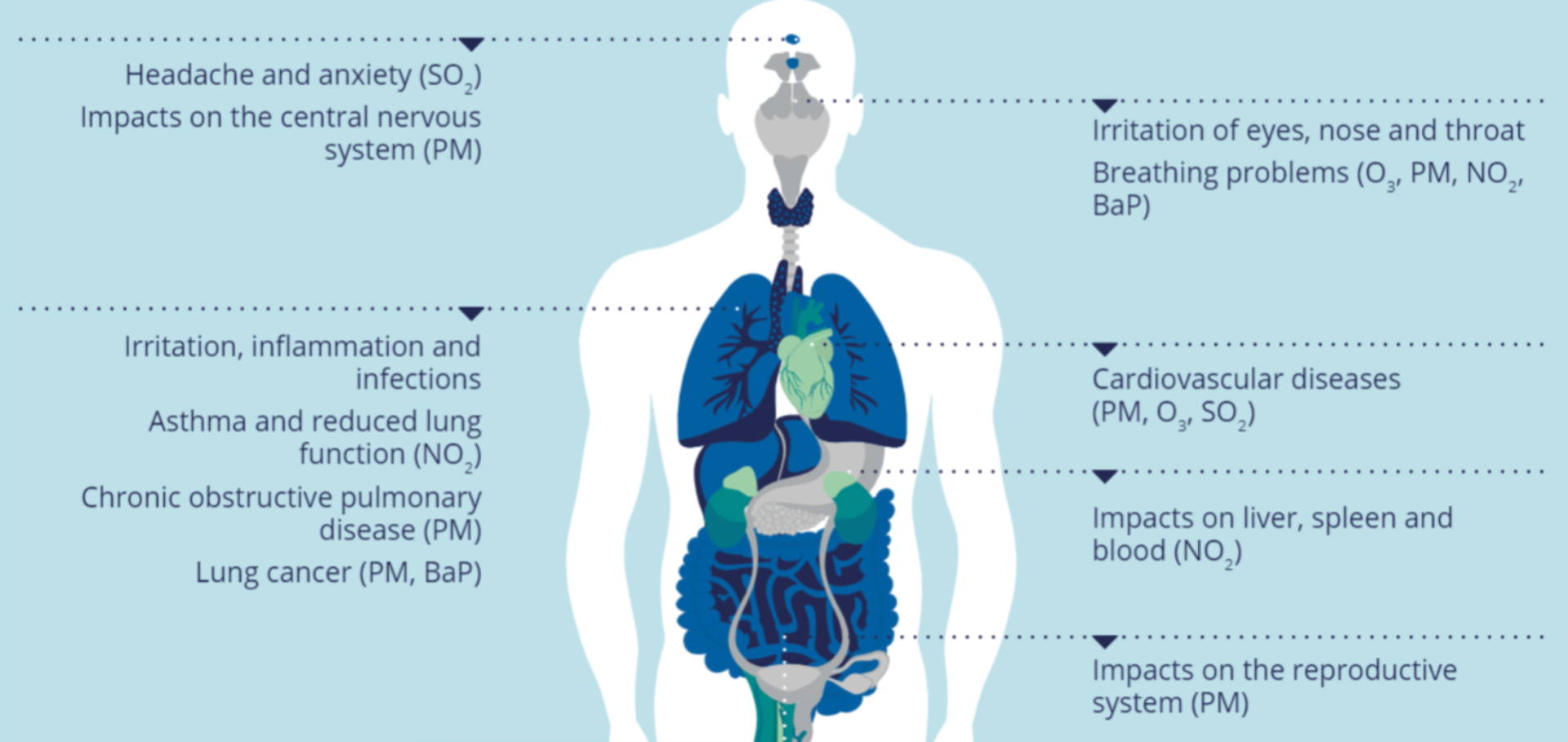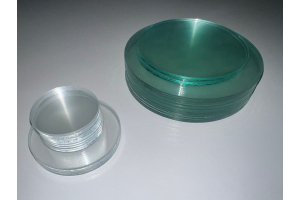

By Luca Masella, M.S.
Reading Time: 16 Minutes
The term "indoor air quality" refers to the air quality in a house, school, workplace, or other building setting. The potential national influence of indoor air quality on human health is relevant for various reasons:
People spend almost 90% of their time indoors where the concentrations of certain pollutants are frequently 2 to 5 times greater than typical outdoor amounts.
Indoor concentrations of various pollutants have risen in recent decades as a result of variables such as energy-efficient building design.
Indoor Pollutants:
- Combustion byproducts such as carbon monoxide (CO), particulate matter (PM), and environmental tobacco smoke.
- Substances of natural origin such as radon (Rn), pet dander, and mold.
- Biological agents such as molds.
- Pesticides, lead (Pb), and asbestos.
- Ozone (O3) from air pressurized cans.
- Various volatile organic compounds (VOCs) from a variety of products and materials.
Sources of indoor pollutants
Indoor combustion sources such as tobacco, wood and coal heating and cooking equipment, and fireplaces can emit dangerous combustion byproducts such as carbon monoxide and particulate matter into the interior environment.
Cleaning supplies, paints, pesticides, and other widely used products release a wide range of chemicals, including volatile organic compounds, into the interior environment.
Building materials, whether decaying ones (e.g., asbestos fibers discharged from building insulation) or new materials, are also possible sources (e.g., chemical off-gassing from pressed wood products). Additional natural contaminants in indoor air include radon, mold, and pet dander.
Sources of outdoor pollutants
Outdoor air contaminants can infiltrate buildings through open doors, open windows, ventilation systems, and structural defects. Several contaminants enter buildings through the foundations. Radon, for example, is formed in the earth as naturally-existing uranium, found in rocks and soils, decays.
Hazardous smoke from chimneys can re-enter, polluting the air in the interiors and surrounding areas. Volatile chemicals can infiltrate buildings through the same way in places with polluted ground water or soils. As building residents utilize the water, volatile substances in the water supply can infiltrate the interior air.
The influence of air quality on human health
Indoor air contaminants have the following health effects:
- Eye, nose, and throat irritation.
- Headaches, dizziness, and weariness are all symptoms.
- Respiratory illnesses, heart disease, and cancer are also common.
The association between several common indoor air pollutants and health impacts (e.g., radon, particle pollution, carbon monoxide, Legionella bacteria) is well documented.
Radon is a proven carcinogen and the second largest cause of lung cancer in humans.
Carbon monoxide is poisonous, and short-term exposure to high quantities of carbon monoxide inside can be fatal.
Legionnaires' disease, a pneumonia caused by Legionella bacteria exposure, has been linked to buildings with poorly maintained air conditioning or heating systems.
Many indoor air pollutants, including dust mites, mold, pet dander, ambient cigarette smoke, cockroach allergens, particulate matter, and others, are "asthma triggers,” which means that asthmatics can develop asthma attacks as a result of exposure.
In a study published in the Building and Environment journal, researchers found that a 50% reduction in volatile organic compounds (VOCs) led to a 30% reduction in symptoms of sick building syndrome (SBS) and a 52% improvement in perceived air quality among workers.
A study published in Environmental Health Perspectives found that increasing levels of carbon dioxide (CO2) led to decreased cognitive function among office workers. Specifically, for every 10 parts per million (ppm) increase in CO2, cognitive function decreased by 21%.
If CO2 levels increase indoors throughout the day, it can have a number of effects on human. Some of the possible effects include:
Drowsiness and fatigue: When the CO2 concentration in the air increases, it can cause people to feel drowsy and tired. This can reduce their productivity and make it difficult for them to concentrate.
Headaches: Higher levels of CO2 in the air can also lead to headaches, which can be mild to severe depending on the individual's sensitivity.
Reduced cognitive function: Studies have shown that increased levels of CO2 in the air can lead to reduced cognitive function, including poor decision-making, reduced attention span, and decreased creativity.
Increased risk of illness: Poor indoor air quality due to increased CO2 levels can increase the risk of respiratory and other illnesses, especially for individuals with pre-existing respiratory conditions.
How to understand if there is bad air quality in your environment.
If you work in an office with poor air quality, you may experience a range of symptoms. Here is a guide to help you understand if your office has poor air quality based on your symptoms:

- Difficulty Breathing: If you find yourself having difficulty breathing, wheezing, or experiencing shortness of breath while at work, it could be a sign of poor air quality. It's possible that the air in the office is filled with pollutants, allergens, or other irritants that are causing respiratory distress.
- Eye Irritation: If you're experiencing eye irritation, such as itching, redness, or watering eyes, it could be a sign of poor air quality. Indoor air pollutants like dust, mold, and chemicals can cause eye irritation.
- Headaches: Headaches are a common symptom of poor indoor air quality. If you experience headaches regularly while at work, it's possible that the air in the office is polluted with harmful chemicals or other irritants.
- Fatigue: If you feel tired or sluggish while at work, this could also be a sign of poor air quality. When the air quality is poor, you may not be getting enough oxygen, which can make you feel fatigued.
- Allergies: If you experience allergy symptoms, such as a runny nose, sneezing, or congestion, while at work, this is another sign of poor air quality. Allergens like dust, pollen, and mold can cause allergic reactions and exacerbate existing allergies.
- Skin Irritation: If you experience skin irritation, such as dryness, itching, or rash, while at work, it could also be a sign of poor air quality. Chemicals and other irritants in the air can cause skin irritation.
Solutions
Air quality sensors are devices that measure the level of air pollution in an environment. These sensors can detect a range of air pollutants such as particulate matter (PM), volatile organic compounds (VOCs), carbon monoxide (CO), and nitrogen dioxide (NO2). Once the sensors detect the air pollutants, the data is transmitted locally or to the cloud via the IoT network, where it is analyzed and processed. The processed data is then used to control HVAC systems and air purifiers to improve IAQ.
Connecting air quality sensors to HVAC systems can enable the system to automatically adjust the airflow, temperature, and humidity levels based on the air quality data. For example, if the air quality sensors detect high levels of PM, the HVAC system can increase the airflow and filter the air more frequently to reduce the PM concentration. Similarly, if the sensors detect high levels of CO, the HVAC system can shut off the combustion appliances and increase the ventilation rate to reduce the CO concentration.
The simplest and most effective way to remove CO2 from indoor air is to increase the amount of outdoor air brought into the building. This can be achieved by adjusting the ventilation rates of the HVAC system. When more outdoor air is brought in, the CO2 levels are diluted with fresh air, and the indoor air quality is improved.
When the CO2 levels exceed a certain threshold, the sensors can signal the HVAC system to increase the ventilation rates or activate the air exchange system to remove the stale air and bring in fresh outdoor air.
Another method to remove CO2 from indoor air is through absorption. HVAC systems can use specialized materials such as zeolite or activated carbon to absorb CO2 from indoor air. These materials can be installed in the HVAC system’s air handlers or ductwork to remove CO2 as air passes through.
Air purifiers are also being integrated with air quality sensors to improve IAQ. Air purifiers are devices that remove air pollutants from the air, using filters or electrostatic precipitators. By connecting air quality sensors to air purifiers, the purifiers can be controlled based on the air quality data. For example, if the sensors detect high levels of VOCs, the air purifier can activate its carbon filter to absorb the VOCs.
Furthermore, IoT technology can enable users to monitor and control the IAQ remotely using their smartphones or computers. This means that users can receive alerts and notifications about the air quality status and control the HVAC and air purifiers remotely.
In conclusion, the integration of IoT technology with air quality sensors, HVAC systems, and air purifiers is a promising solution for improving IAQ and enhancing human health and wellbeing. By using real-time air quality data, HVAC systems and air purifiers can be controlled automatically to reduce air pollutants and maintain a healthy indoor environment. This technology has the potential to revolutionize the way we interact with our environment and provide a safer and healthier indoor environment for everyone.
Results
According to a study published in the International Journal of Environmental Research and Public Health, an improvement in indoor air quality led to a 5.5% increase in productivity among call center employees.
Another study published in the Journal of Environmental Psychology found that improved ventilation rates led to a 2% increase in productivity among office workers.
A study published in the International Journal of Environmental Research and Public Health found that employees in a green-certified building reported a 26% increase in cognitive function compared to those in non-certified buildings.
Another study published in the Journal of Environmental Psychology found that better air quality in a classroom led to improved test scores and cognitive function among students.
Another study by the Lawrence Berkeley National Laboratory found that workers in a green-certified building with good indoor air quality performed better on cognitive tests and had 30% fewer sick building symptoms than workers in a conventional building.
Based on these studies, it is reasonable to expect that an employee in an office with good air quality could be 10-30% more productive than an employee in an office with poor air quality.
However, it is important to note that the exact percentage increase in productivity may vary depending on the specific workplace environment and the individuals working in it.
Legend:
| S02 | Sulfur dioxide |
| PM | Particulate matter |
| NO2 | Nitrogen dioxide |
| BaP | Benzo[a]pyrene |
| O3 | Ozone |
References:
Indoor Air Quality (2021). Available at: https://www.epa.gov/report-environment indoor-air-quality.
U.S. Environmental Protection Agency. 2003. EPA assessment of risks from radon in homes. EPA/402/R-03/003. Washington, DC.
National Research Council. 1999. Health effects of exposure to indoor radon: biological effects of ionizing radiation (BEIR), report VI. Washington, DC: National Academies Press.
Writer, C.W.H.S. (2018). Your building might be making you sick. Joe Allen can help. [online] Harvard Gazette. Available at: https://news.harvard.edu/gazette/story/2018/02/your [Accessed 7 Apr. 2023].
MacNaughton, P., Satish, U., Laurent, J.G.C., Flanigan, S., Vallarino, J., Coull, B., Spengler, J.D. and Allen, J.G. (2017). The impact of working in a green certified building on cognitive function and health. Building and Environment, [online] 114, pp.178–186. doi:https://doi.org/10.1016/j.buildenv.2016.11.041.
Thatcher, A. and Milner, K. (2014). Changes in productivity, psychological wellbeing and physical wellbeing from working in a ‘green’ building. Work, [online] 49(3), pp.381–393. doi:https://doi.org/10.3233/WOR-141876.
Allen, J.G., MacNaughton, P., Satish, U., Santanam, S., Vallarino, J. and Spengler, J.D. (2016). Associations of Cognitive Function Scores with Carbon Dioxide, Ventilation, and Volatile Organic Compound Exposures in Office Workers: A Controlled Exposure Study of Green and Conventional Office Environments. Environmental Health Perspectives, 124(6), pp.805–812. doi:https://doi.org/10.1289/ehp.1510037.





